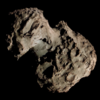| Discovery | |
|---|---|
| Discovered by | NASA Jet Propulsion Laboratory, announced by S.H. Pravdo, Named after NEAT Observatory in Hawaii (608)[1] |
| Discovery date | November 6, 2002 |
| Designations | |
| C/2002 V1, 2002 V1, Comet NEAT | |
| Orbital characteristics | |
| Epoch | 2452634.5 (December 26, 2002) |
| Aphelion | ~2,230 AU[2] (Q) |
| Perihelion | 0.099258 AU (q) |
| Semi-major axis | ~1,100 AU[2] (a) |
| Eccentricity | 0.999017 |
| Orbital period | ~37,000 yr[2][3] |
| Inclination | 81.706° |
| Last perihelion | February 18, 2003 |
| Next perihelion | unknown |
Comet C/2002 V1 (NEAT) is a non-periodic comet that appeared in November 2002.[1] The comet peaked with an apparent magnitude of approximately –0.5, making it the eighth-brightest comet seen since 1935.[4] It was seen by SOHO in February 2003. At perihelion the comet was only 0.099258 astronomical units (14,848,800 kilometres; 9,226,600 miles) from the Sun. (Slight controversy arose when the comet failed to break up when it approached the Sun, as expected by some scientists if it were a small comet.)[5]
The comet was hit by a coronal mass ejection during its pass near the Sun.[6] Speculation that the CME was caused by the comet's close approach was dismissed by scientists; comets and CMEs occur close together in time only by coincidence,[5][7] and there were 56 CMEs in February 2003.[8] On February 18, 2003, comet C/2002 V1 (NEAT) passed 5.7 degrees from the Sun.[9] C/2002 V1 (NEAT) appeared impressive as viewed by the Solar and Heliospheric Observatory (SOHO) as a result of the forward scattering of light off of the dust in the coma and tail. After the comet left LASCO's field of view, on February 20, 2003, an object was seen at the bottom of a single frame.[10] Although technicians dismissed this as a software bug, rumours persisted that the object had been expelled from the Sun.
The orbit of a long-period comet is properly obtained when the osculating orbit is computed at an epoch after leaving the planetary region and is calculated with respect to the center of mass of the solar system. Using JPL Horizons, the barycentric orbital elements for epoch 2020-Jan-01 generate a semi-major axis of 1,100 AU, an apoapsis distance of 2,230 AU, and a period of approximately 37,000 years.[2]
YouTube Encyclopedic
-
1/3Views:38 1622 956746
-
Comet NEAT C/2002 V1 2003
-
Three of the Biggest Comets from the LASCO C3 Camera.
-
Newly Discovered Comet is a Goner: Oct 21st, 2010.
Transcription
References
- ^ a b "MPEC 2002-V31 : COMET C/2002 V1 (NEAT)". IAU Minor Planet Center. 2002-11-07. Retrieved 2011-04-07.
- ^ a b c d Horizons output. "Barycentric Osculating Orbital Elements for Comet C/2002 V1 (NEAT)". Retrieved 2011-04-06. (Solution using the Solar System Barycenter and barycentric coordinates. Select Ephemeris Type:Elements and Center:@0)
- ^ Kronk, Gary W. "C/2002 V1 (NEAT)". Cometography. p. 1. Archived from the original on 2008-05-11. Retrieved 2008-08-05.
- ^ "Brightest comets seen since 1935". Harvard. 2009-02-12. p. 1. Archived from the original on 2011-12-28. Retrieved 2011-04-07.
- ^ a b Britt, Robert Roy (28 February 2003). "Alleged NASA Cover-up of Menacing 'NEAT' Comet Threat is Pure Bunk, Experts Say". Space.com. Retrieved 2008-08-05. (Yahoo Groups)
- ^ Britt, Robert Roy (18 February 2003). "Amazing Live Images: Sungrazing Comet Possibly Hit by Solar Eruption". Space.com. Retrieved 2008-08-05. (A solar eruption, called a coronal mass ejection (CME), appears to have hit the comet Monday, Brekke said. Scientists think they observed a kink propagating down the comet's ion tail.)
- ^ "Big comet, big CME... big coincidence?". Sungrazing Comets. October 4, 2011. Retrieved 2011-10-04.
- ^ "56 CME in 2003/02" (At 05:57:07). Solar Influences Data Analysis Center (SIDC / CACTus catalogue). 13 September 2010. Retrieved 2011-10-07. (CME rate)
- ^ Horizons output. "Observer Table for Comet C/2002 V1 (NEAT)". Retrieved 2011-09-07. (Observer Location:500) (APOD)
- ^ SOHO C3 image from 2003-Feb-20 23:42
External links
- "JPL Small-Body Database Browser". NASA.
- Surf the Web to see the Sun-dancing comet (ESA 2003-Feb-12)
- Comet Neat Passes an Erupting Sun (APOD 2003 February 24)
- Spacewatch Friday: Promising New Comet Called NEAT (C/2002 V1) Graces Evening Sky – Space.com
- News story as comet hit by Coronal Mass Ejection
- Article about the Comet NEAT Conspiracy
- Images of Comet NEAT taken by LASCO during perihelion
- SOHO Hotshots of Comet NEAT


